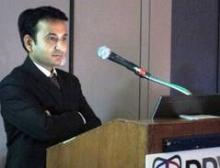CHICAGO – A full 13% of patients diagnosed with hepatocellular carcinoma did not have underlying cirrhosis in a national sample of 1,500 veterans.
Although hepatocellular carcinoma (HCC) in patients with cirrhosis typically arises against a background of alcohol abuse or hepatitis C virus infection, this entity was strongly associated with nonalcoholic fatty liver disease (NAFLD) and idiopathic HCC.
"While this represents a small proportion, this poses a logistical problem for HCC surveillance, given the large population with NAFLD and no real identifying features of who is going to develop HCC," Dr. Sahil Mittal said at the annual Digestive Disease Week.
Despite a threefold increase in HCC in the United States over the last 3 decades and emerging evidence for NAFLD presenting in the absence of cirrhosis, this is the first study to assess the prevalence and risk factors for HCC without cirrhosis in a national sample of HCC patients, he said.
The investigators, led by Dr. Hashem B. El-Serag, section chief, gastroenterology and hepatology, Baylor College of Medicine, Houston, performed a chart review of 1,500 veterans with a confirmed diagnosis of HCC randomly selected between 2005 and 2011. Of these, cirrhosis was absent in 43 (3%), highly improbable in 151 (10%), and definite in 1,201 (80%), with the diagnosis unclear because of insufficient data in 105 (7%).
As expected, HCC patients with cirrhosis were significantly more likely than those with no or probable no cirrhosis to abuse alcohol (84% vs. 67.4% vs. 63.6%; P less than .01) and to have hepatitis C infection (72.2% vs. 42% vs. 44.4%; P less than .01), said Dr. Mittal, also with Baylor’s College of Medicine.
Hepatitis B infection was similar in all three groups (5% vs. 4.7% vs. 2%).
In contrast, NAFLD was more common in patients with no or probably no cirrhosis than in those with cirrhosis (14% vs. 20.5% vs. 5.8%; P less than .01), as was idiopathic HCC (18.6% vs. 27.8% vs. 8.2%; P less than .01), he said.
"NAFLD is associated with a significantly increased risk of HCC in the absence of cirrhosis, compared with hepatitis C or alcohol," he said.


